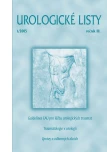STRESS URINARY INCONTINENCE IN WOMEN AND ITS PHARMACOLOGIC TREATMENT OPTIONS
Authors:
prof. MUDr. Tomáš Hanuš, DrSc.
Authors‘ workplace:
Urologická klinika 1. LF UK a VFN, Praha
Published in:
Urol List 2005; 3(1): 56-62
Overview
In the form of summary survey, the author of this report addresses the stress urinary incontinence in women. He briefly mentions its distinction from other types of urinary incontinence, its classification, pathophysiology, etiology including the most significant risk factors of its creation and epidemiologic data. Further he deals with the reasons of insufficient solution of this problem and its economic impacts. In the conclusive part he presents an overview of stress urinary incontinence treatment options, aiming at pharmacotherapy options, including an up-to-date information of duloxetin, dual inhibitor of reverse trapping of serotonin and noradrenalin in CNS, which was recently registered in EU for the treatment of stress urinary incontinence in women.
KEY WORDS:
stress urinary incontinence, prevalence, conservative therapy, pharmacotherapy, duloxetin
Sources
1. Abrams P et al. The standardisation of terminology of lower urinary tract function: report from the Standardisation Sub-committee of the International Continence Society. Neurourol Urodyn 2002; 21: 167-178.
2. Hunskaar S et al. The prevalence of urinary incontinence in women in four European countries. BJU International 2004; 93: 324-330.
3. Voelker R. International Group Seeks to Dispel Incontinence "Taboo". JAMA 1998; 11: 951-953.
4. Hampel C et al. Definition of overactive bladder and epidemiology of urinary incontinence. Urology 1997; 50 (Suppl 6A): 4-14.
5. Weidner AC et al. Which women with stress incontinence require urodynamic evaluation? Am J Obstet Gynecol 2000; 184: 20-27.
6. Koelbl H et al. Pathophysiology. In: Abrams P et al. Incontinence. 2nd ed. Plymouth: Plymbridge 2002: 203-241.
7. Bump RC et al. Epidemiology and natural history of pelvic floor dysfunction. Obstet Gynecol Clin North Am 1998; 25: 723-746.
8. Viktrup L. The risk of lower urinary tract symptoms five years after the first delivery. Neurourol Urodyn 2002; 21: 2-29.
9. Moller LA et al. The prevalence and bothersomeness of lower urinary tract symptoms in women 40-60 years of age. Acta Obstet Gynecol Scand 2000; 79: 298-305.
10. Thom D. Variation in estimates of urinary incontinence prevalence in the community: Effects of differences in definition, population characteristics, and study type. J Am Geriatr Soc 1998; 46: 473-480.
11. Graham CA, Naplett VT. Race as a predictor of urinary incontinence and pelvic organ prolapse. Am J Obstet Gynecol 2001; 185: 116-120.
12. Sze EHM et al. Prevalence of urinary incontinence symptoms among Black, White and Hispanic woman. Obstet Gynecol 2002; 9: 572-575.
13. Thyssen HH et al. Urinary incontinence in elite female athletes and dancers. Int Urogynecol J 2002; 13: 72-75.
14. Buchsbaum GM et al. Prevalence of urinary incontinence and associated risk factors in a cohort of nuns. Obstet Gynecol 2002; 100: 226-229.
15. Maral I et al. Prevalence of stress urinary incontinence in both sexes at or after age 15 years: a cross-sectional study. J Urol 2001; 165: 408-412.
16. Hannestad YS et al. A community-based epidemiological survey of female urinary incontinence: The Norwegian EPINCONT Study. J Clin Epidemiol 2000; 53: 1150-1157.
17. Minassian VA et al. Urinary incontinence as a worldwide problem. Int J Gynecol Obstet 2003; 82: 327-338.
18. Hanuš T. Epidemiologie inkontinence moči. Uro List 2004; 1: 14-18.
19. Fultz NH et al. Burden of stress urinary incontinence for community-dweling women. Am J Obstet Gynecol 2003; 189: 1275-1282.
20. Wilson L et al. Annual direct cost of urinary incontinence. Obstet Gynecol 2001; 98: 398-406.
21. Kinchen K et al. A retrospective claims analysis of the direct costs of stress urinary incontinence. Int Urogynecol J Pelvic Floor Dys 2003; 14: 403-411.
22. Hay-Smith EJ et al. Cochrane Database Syst Rev 001; 1: CD001407.
23. Zinner NR et al. Pharmacotherapy for stress urinary incontinence: Present anf future options. Drugs 2004; 64: 1503-1516.
24. Grady D et al. Postmenopausal hormones nd incontinence: the Heart and Estrogen/Progestin Replacement Study. Obstet Gynecol 2001; 97: 116-120.
25. Victrup L, Bump RC. Pharmacological agents used for the treatment of stress urinary incontinence in women. Current Med Res Opin 2003; 19: 485-490.
26. Andersson KE et al. Pharmacological treatment of urinary incontinence. In: Abrams P et al. Incontinence. 2nd ed. Plymouth: Plymbridge 2002: 479-511.
27. Thor KB, Katofiasc MA. Effects of duloxetine, a combined serotonin and norepinefrine reuptake inhibitor, on central neural control of lower urinary tract function in the chloralose anesthetized female cat. J Pharmacol Exp Ther 1995; 274: 1014-1024.
28. Yentreve Summary of Product Characteristics. http://www.emea.eu.int/humandocs/Humans/EPAR/yentreve/yentreve.htm
29. Kerrebroeck P. Duloxetine: an innovative approach for treating stress urinary incontinence. BJU International 2004; 94 (Suppl 1): 31-37.
30. Dmochowski RR et al. Duloxetine versus placebo for the treatment of North American women with stress urinary incontinence. J Urol 2003; 170: 1259-1263.
31. Cardozo L et al. Pharmacological treatment of women awaiting surgery for stress urinary incontinence. Obstet Gynecol 2004; 104: 511-519.
Labels
Paediatric urologist UrologyArticle was published in
Urological Journal

2005 Issue 1
Most read in this issue
- OPTIMAL METHOD OF INTRAABDOMINAL PRESSURE MEASUREMENT
- INJURIES TO THE EXTERNAL GENITAL ORGANS
- URETHRAL TRAUMA IN MALES - IMMEDIATE AND DELAYED TREATMENT
- BLADDER TRAUMA
